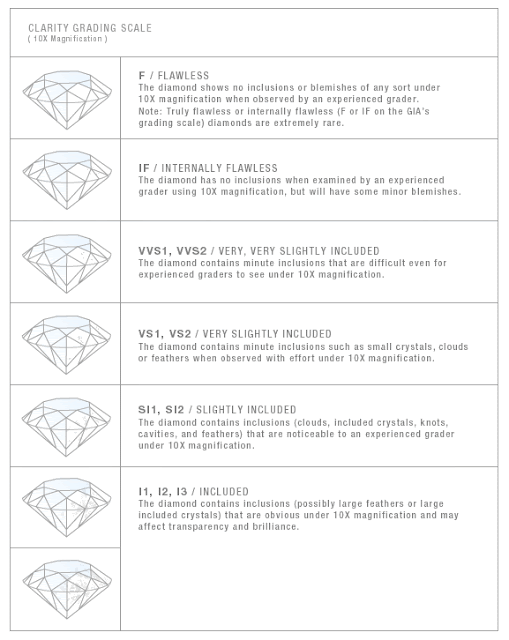Diamond Clarity:
No two diamonds are alike. A diamond's most distinguishing characteristics are its inclusions, marks that are often invisible to the naked eye. However, under a jeweler's magnifying loupe or microscope they can look like crystals, tiny rivers, or clouds. A diamond's clarity is determined by the presence or absence of inclusions--fewer inclusions mean better clarity--and how visible they are. The greater a diamond's clarity, the greater its brilliance and value. A diamond categorized as internally flawless will have no inclusions, but this is extremely rare.
Diamond Color:
Though diamonds come in a wide range of colors, colorless diamonds have traditionally been considered the most valuable. Most diamonds are graded on a scale using the letters of the alphabet, from D (colorless), the best grade, through Z (a light yellow). It is difficult for the untrained eye to notice such variations in color unless stones are being compared side by side.
Diamond Carat Weight:
A diamond's weight is measured in carats, with one carat being equivalent to 100 points. You will often see a diamond referred to as a 3/4-carat stone or a 75-point diamond. Larger stones are often more highly valued, but size should not be the only consideration--high brilliance, which varies according to clarity, cut, and color grade, is highly desirable in a diamond.
Diamond Certification:
A diamond certificate represents independent verification that the stone purchased has all the qualities of cut, color, clarity, shape, and weight expected. It is a further indication of the condition and value of that diamond as represented on our site. Such certificates are issued by several agencies employing highly trained gemologists and provide an unbiased and accurate evaluation of the diamond. These gemologists scrutinize each stone to analyze its dimensions, clarity, cut, color, finish, symmetry, and other details.
Diamonds purchased from the Amazon.com Collection may be certified by the Gemological Institute of America or the International Gemological Institute. The type of certificate provided will be noted in the product specifications of your jewelry purchase; if you do not see a certificate type noted, one will not be provided.
Diamond Care:
Diamonds, as the hardest substance on earth, are resistant to damage. However, diamond jewelry is set in different metals, and care will vary from piece to piece. Diamonds should be cleaned in a solution of one part ammonia to six parts water, using a gentle scrubbing brush to remove any dirt. It is a good idea to have them cleaned once a year by a professional jeweler, at which time the security of the setting can be checked as well. Diamond jewelry should be stored in a soft cloth pouch to ensure that the stone will not scratch other jewelry.
skip to main |
skip to sidebar
picture wallpaper.sexy eva wallpaper.hair wallpaper.all wallpaper.dll
Followers
Blog Archive
-
▼
2011
(1960)
-
▼
January
(50)
- Faith
- OPI Texas Line
- Oh Charlie Sheen!
- 2011 is the year for Britney Spears…
- The Return of …
- Pop Culture Fashionista or Faux Fashionista: Jessi...
- In more Kim Kardashian news…
- I can’t get enough of seeing…
- For My Olives.....
- I Miss You....
- A Reason To Live
- In movie news…
- Big Changes for Material Girl!
- Are you rockin Neon Colors in the Spring/Summer?
- Keith Olbermann says goodbye to MSNBC
- Oh those Kardashians
- In what the H*ll news…
- Pop Culture Fashionista or Faux Fashionista: Jenni...
- Pop Culture Fashionista or Faux Fashionista: Miche...
- Golden Globes 2011: Hits and Misses
- Zodiac Sign Confusion!! Has your sign changed?
- Pop Culture Fashionista or Faux Fashionista: Criti...
- Kanha
- Small is Big-The Fine Art of Giving
- Tips for dry skin
- Diamond Ring Photos
- My love for Tom Ford
- The new it bag of 2011?
- There must be something in the water….
- PROTOONS
- An African- American Bachelor?
- Anne Hathaway, Eva Longoria and Cheryl Cole Brace...
- Paris Hilton In Necklace
- Kim Kardashian and Her Necklace
- Tatyana Ali stars in "Love That Girl"
- Essie coming to Walgreens?
- Jennifer Hudson looking HoTT
- Victoria Beckham is Pregnant!
- Celebrity diamond engagement ring
- Top 10 Celebrity Engagement Rings
- About Diamonds
- Of Love-Hate Relationships
- The Christmas Gift
- Pop Culture Fashionista or Faux Fashionista: Khloe...
- The real millionaires
- Girl Crush: Gwyneth Paltrow
- Let’s do a giveaway!
- Britney Spears’ new album cover
- Pop Culture Fashionista or Faux Fashionista: Beyoncé
- Gossip Gossip Gossip!
-
▼
January
(50)
Powered by Blogger.


